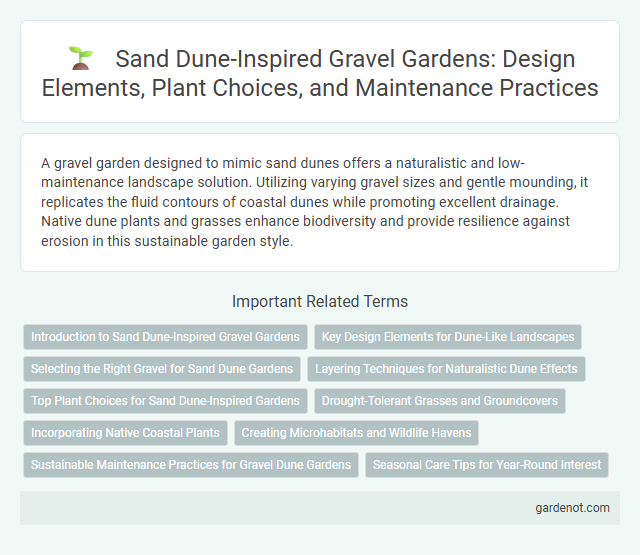A gravel garden designed to mimic sand dunes offers a naturalistic and low-maintenance landscape solution. Utilizing varying gravel sizes and gentle mounding, it replicates the fluid contours of coastal dunes while promoting excellent drainage. Native dune plants and grasses enhance biodiversity and provide resilience against erosion in this sustainable garden style.
Introduction to Sand Dune-Inspired Gravel Gardens
Sand dune-inspired gravel gardens replicate the natural contours and textures of coastal sand dunes using a blend of fine gravel, native grasses, and low-growing succulents. This design enhances soil drainage and supports drought-resistant plants, creating sustainable, low-maintenance landscapes ideal for arid regions. Incorporating patterns that mimic wind-blown ridges and troughs optimizes water retention while providing a visually dynamic garden space.
Key Design Elements for Dune-Like Landscapes
Key design elements for sand dune mimic in gravel gardens include undulating mounds that replicate natural dune shapes, strategically placed native grasses like Ammophila arenaria to stabilize soil, and a layered gravel palette with varying grain sizes and colors to emulate shifting sands. Incorporating driftwood or weathered stones enhances authenticity while promoting biodiversity. Proper grading ensures effective water drainage and prevents erosion, completing the resilient dune-like landscape structure.
Selecting the Right Gravel for Sand Dune Gardens
Choosing the right gravel for sand dune gardens involves selecting materials that replicate natural coastal textures and support proper drainage, such as quartz or limestone gravel with varied grain sizes. Gravel should be loosely packed to mimic the airy, shifting nature of sand dunes, promoting aeration and healthy root growth for salt-tolerant plants. Opting for light-colored gravel also helps reflect sunlight, maintaining soil temperature similar to natural dune ecosystems.
Layering Techniques for Naturalistic Dune Effects
Layering techniques in sand dune mimicry create depth and texture essential for naturalistic gravel garden designs. Utilizing varied gravel sizes and colors simulates the stratification found in real dunes, enhancing visual interest and realism. Incorporating organic elements like driftwood or native dune plants further complements the layered effect, mimicking natural coastal environments.
Top Plant Choices for Sand Dune-Inspired Gardens
Top plant choices for sand dune-inspired gardens include beach grass (Ammophila breviligulata), sea oats (Uniola paniculata), and beach pea (Lathyrus japonicus), all renowned for their sand stabilization and salt tolerance. These plants thrive in well-drained, nutrient-poor sandy soils and contribute to mimicking natural dune ecosystems. Incorporating native dune species such as seaside goldenrod (Solidago sempervirens) and beach heather (Hudsonia tomentosa) further enhances biodiversity and resilience in sand dune garden designs.
Drought-Tolerant Grasses and Groundcovers
Sand dune mimic gardens rely on drought-tolerant grasses like Festuca rubra and Ammophila arenaria, which stabilize soil and prevent erosion. Groundcovers such as Sedum acre and Delosperma cooperi thrive in sandy, nutrient-poor soils by conserving moisture and reducing evaporation. These plants create a resilient, low-maintenance landscape ideal for xeriscaping and coastal-inspired gravel gardens.
Incorporating Native Coastal Plants
Incorporating native coastal plants such as sea thrift (Armeria maritima), beach grass (Ammophila breviligulata), and sea holly (Eryngium maritimum) enhances the authenticity of a sand dune mimic gravel garden. These species are adapted to sandy, nutrient-poor soils and salt spray, promoting soil stabilization and biodiversity. Utilizing native flora improves sustainability and resilience while supporting local wildlife habitats in coastal environments.
Creating Microhabitats and Wildlife Havens
Sand dune mimic gardens replicate diverse microhabitats by incorporating native grasses, sandy soils, and salt-tolerant plants that provide shelter and food for pollinators, ground-nesting birds, and small mammals. These gardens promote biodiversity by establishing conditions similar to coastal dunes, enabling specialized wildlife species to thrive in urban or inland settings. Creating such microhabitats enhances ecosystem services like erosion control, moisture retention, and natural pest management, fostering resilient garden environments.
Sustainable Maintenance Practices for Gravel Dune Gardens
Sustainable maintenance practices for gravel dune gardens prioritize water conservation by utilizing drought-tolerant plants that mimic natural sand dune ecosystems, reducing irrigation needs. Incorporating native vegetation and organic mulch helps stabilize soil, prevent erosion, and support local biodiversity within the gravel landscape. Regular monitoring of soil health and minimal disturbance techniques ensure long-term sustainability and resilience of the gravel dune garden environment.
Seasonal Care Tips for Year-Round Interest
Sand dune mimic plants thrive in gravel gardens by replicating coastal environments with well-drained, sandy soils and ample sunlight. Seasonal care involves minimal watering during dry periods and occasional pruning in late winter to maintain shape and encourage new growth. Mulching with coarse sand or small pebbles helps retain moisture and prevents soil erosion, ensuring year-round interest and durability in the garden landscape.
Sand dune mimic Infographic

 gardenot.com
gardenot.com